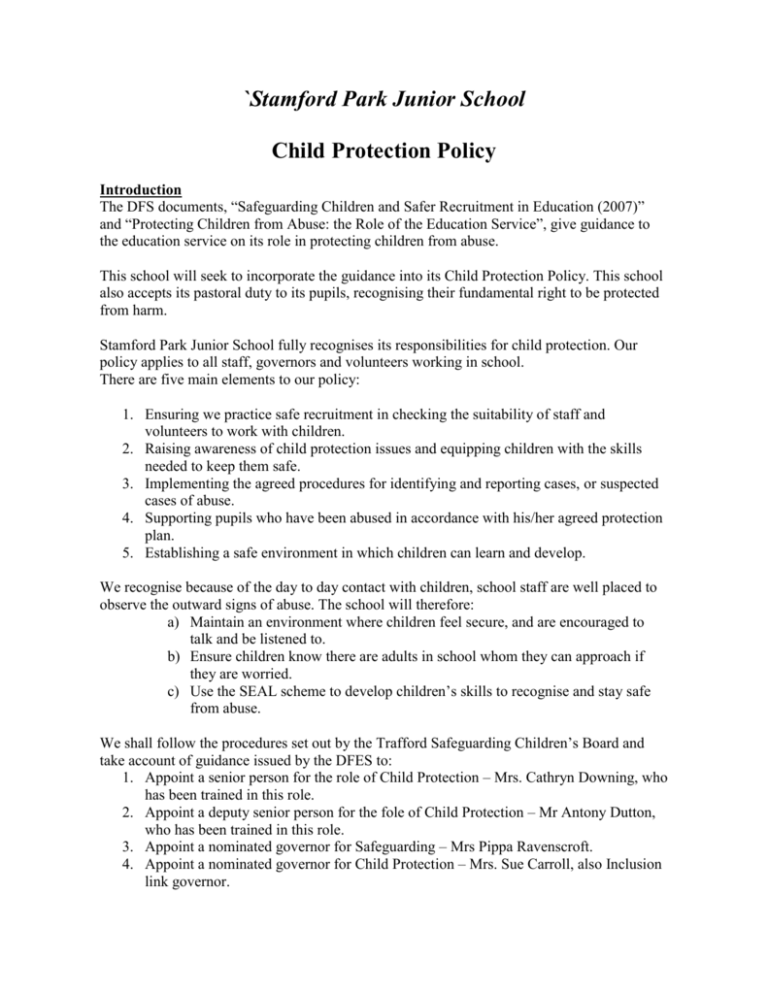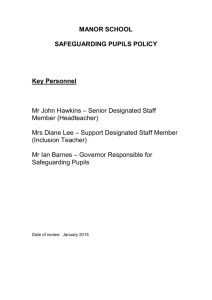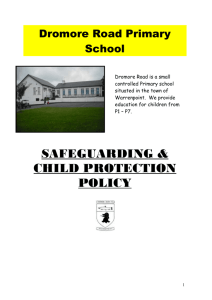
`Stamford Park Junior School
Child Protection Policy
Introduction
The DFS documents, “Safeguarding Children and Safer Recruitment in Education (2007)”
and “Protecting Children from Abuse: the Role of the Education Service”, give guidance to
the education service on its role in protecting children from abuse.
This school will seek to incorporate the guidance into its Child Protection Policy. This school
also accepts its pastoral duty to its pupils, recognising their fundamental right to be protected
from harm.
Stamford Park Junior School fully recognises its responsibilities for child protection. Our
policy applies to all staff, governors and volunteers working in school.
There are five main elements to our policy:
1. Ensuring we practice safe recruitment in checking the suitability of staff and
volunteers to work with children.
2. Raising awareness of child protection issues and equipping children with the skills
needed to keep them safe.
3. Implementing the agreed procedures for identifying and reporting cases, or suspected
cases of abuse.
4. Supporting pupils who have been abused in accordance with his/her agreed protection
plan.
5. Establishing a safe environment in which children can learn and develop.
We recognise because of the day to day contact with children, school staff are well placed to
observe the outward signs of abuse. The school will therefore:
a) Maintain an environment where children feel secure, and are encouraged to
talk and be listened to.
b) Ensure children know there are adults in school whom they can approach if
they are worried.
c) Use the SEAL scheme to develop children’s skills to recognise and stay safe
from abuse.
We shall follow the procedures set out by the Trafford Safeguarding Children’s Board and
take account of guidance issued by the DFES to:
1. Appoint a senior person for the role of Child Protection – Mrs. Cathryn Downing, who
has been trained in this role.
2. Appoint a deputy senior person for the fole of Child Protection – Mr Antony Dutton,
who has been trained in this role.
3. Appoint a nominated governor for Safeguarding – Mrs Pippa Ravenscroft.
4. Appoint a nominated governor for Child Protection – Mrs. Sue Carroll, also Inclusion
link governor.
5. Ensure all staff knows who the designated person is including temporary staff and
volunteers.
6. Ensure that all staff understand their responsibilities in being alert to the signs of
abuse and responsibility to inform the designated person.
7. Inform Parents through the school brochure of the schools responsibility.
8. Notify Social services within two working days if a child subject to a child protection
plan is absent.
9. Develop effective links with agencies and co-operate as required including attending
case conferences.
10. Keep written records of concerns, even when there is no need to report them
immediately.
11. Keep written records on CP locked away from Child’s main records.
12. Develop and follow procedures where allegations are made against a member of staff.
13. Ensure safe recruitment practices are always followed.
We recognise that children who are abused or witness violence may find it difficult to develop
a sense of self worth. They may feel helplessness and some sense of blame. The school may
be the only stable, secure and predictable element in the lives of children at risk. When at
school their behaviour may be challenging and defiant or may be withdrawn. The school will
endeavour to support the pupil through:
a) Curriculum content.
b) School ethos promoting a positive, supportive and secure environment giving the
pupil a sense of being valued.
c) School behaviour policy.
d) Liaising with other agencies – Social services, EWO, Ed. Psyc., School nurse etc.
e) Ensure if a child is subject to a child protection plan, all records are transferred when
the child leaves and the Childs social worker is informed.
Review
The school’s policy and procedures for Child Protection will be reviewed annually, by the
curriculum Committee of the Governing Body.
This Policy applies to the Head Teacher, all staff (including supply and peripatetic staff,)
volunteers, governors or anyone working on behalf of Stamford Park Junior School.
Appendix
Recognising abuse.
Categories of abuse as defined in “Working together Under the Child Act 1989” including:1) Neglect:
persistent or severe neglect, or failure to protect a child from exposure
to any kind of danger, including cold or starvation, or extreme failure to carry out
important aspects of care, resulting in the significant impairment of the child’s health
or development, including non-organic failure to thrive;
2) Physical injury:
actual or likely physical injury to a child, or failure to prevent
physical injury (or suffering) to a child including deliberate poisoning, suffocation and
Munchausen’s syndrome by proxy;
3) Sexual abuse:
actual or likely sexual exploitation of a child or adolescent. The
child may be dependent and/or developmentally immature;
4) Emotional abuse:
actual or likely severe adverse effect on the emotional and
behavioural development of a child caused by persistent or severe emotional illtreatment or rejection.
In addition, guidance on recognition of abuse is given in Trafford’s Safeguarding Children’s
Board Procedural Guide.
Procedures in school
If any member of staff has any suspicions or concerns relating to child protection issues,
she/he should inform the designated teacher IMMEDIATELY.
(In the case of suspected sexual abuse no attempt should be made to discuss the suspected
abuse with either child or parent.)
The evidence giving rise to the concern should be recorded accurately and factually, by the
member of staff having the concerns, on Trafford’s proforma, “Notification and Report of
Suspected/Alleged Child Abuse” – see Appendix 1.
This report should be handwritten to preserve confidentiality.
The designated teacher will follow the procedures set out in Trafford’s Safeguarding
Children’s Board Procedures.
Dealing with Disclosure
If a child discloses information to a member of staff, which indicates possible child abuse, the
situation will need handling with great care and sensitivity.
The child may need reassurance and support that they have done the right thing in sharing the
information.
Confidentiality
If a child asks the member of staff to keep the information secret, no such guarantee should be
given. It should be carefully explained to the child that the school has a responsibility to refer
such incidents to the appropriate agencies, for their own sake.
Assurances should be given, however, that the matter will be disclosed only to the people who
need to know.
Abuse by a member of staff
Where there are accusations or suspicions of abuse by a member of staff, the Head must be
informed immediately.
If an allegation is made against the Head, the Deputy Head must be informed.
The procedures outlined in the Trafford’s Safeguarding Children’s Board Procedural Guide
will then be followed.
Monitoring and Recording
Monitoring and recording in the following circumstances.
a) Where the school has consulted with the SSD and a decision has been taken to
monitor the child, rather than for the SSD to become immediately involved.
b) Where there has been an SSD investigation but no case conference, and the school still
has concerns.
c) Where the child has been the subject of a Child Protection Conference, but a decision
is taken not to register the child.
d) Where a named pupil is the subject of an interagency Child Protection Plan.
All notes should:
Be written on the school’s “Monitoring Sheet” (Appendix 2.)
Be factual, objective and accurate.
Include dates, times, events, examples of behaviour and pupil comments, as appropriate.
Be passed to the designated teacher for collation.
Remain confidential and only shared with other staff on a ”need to know” basis.
Be kept in a confidential file “Cause for Concern,” locked in the Head’s Office.
Parents do not have the right of access to notes and reports relating to Child Protection.
However, the notes and records may be required for any subsequent case conference to which
parents are invited.
Notes and records may also be required in the event of a prosecution.
Staff support
Stress on staff involved in all aspects of Child Protection is considerable and the school will
ensure that staff are properly supported.
The Head will be responsible for supporting the staff concerned and, where necessary,
seeking help from outside the school.
Parents
Information about the School’s responsibility with regard to Child Protection is given in the
school prospectus.
Training
The school recognises the importance of training for all staff and they have training to Level 1
every three years. Training for the designated teacher (Head) is seen as a priority, with
training at Level 2 and 3 every two years. This is also prioritised for the Deputy Head for
those occasions when he/she is ‘acting up.’ The designated teacher will disseminate updated
information on Child Protection issues, as appropriate.
Information regarding Child Protection is given in the “Teaching Staff Handbook” and the
“Handbook for Mid-day Assistants and Lunch-time Organisers.”
Child Protection and the Curriculum.
The issue of Child Protection should not be seen in isolation, but rather, dealt with in the
context of the curriculum as a whole.
Certain areas of the curriculum will lend themselves as vehicles for covering such issues. The
Health Education Policy is particularly useful in this respect.
Other matters relating to personal safety will be discussed, within the context of the classroom
or during school assemblies e.g. Road Safety, Safety in the Home and at School, Firework
Code, Stranger Danger, IT safe use etc.
The use of outside agencies for talk or visits will be employed where appropriate e.g. Road
Safety, the Police, Crucial Crew visit etc.
All of these approaches will be designed to make pupils less vulnerable to a variety of risks
including abuse.
CAD 2010












